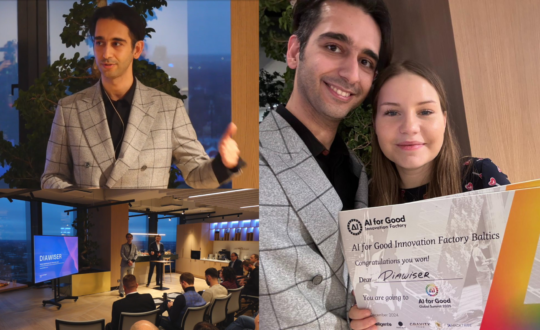During the AI for Good Global Summit, Unbabel’s co-founder and Chief Executive, Vasco Pedro, showcased groundbreaking advancements aimed at reconnecting
Amyotrophic lateral sclerosis (ALS) patients with their loved ones. The session, moderated by Sumner L. Norman, highlighted how Unbabel is leveraging AI and non-invasive brain-machine interfaces to enhance communication for individuals suffering from neurological disabilities.
Bridging the Communication Gap
Unbabel, an AI-driven language translation platform, has been making significant strides in combining machine learning with human translation to deliver top-tier multilingual content. At the summit, Pedro introduced their latest innovation, the Halo device, which utilizes generative AI and non-invasive neural interfaces to translate bio-signals into coherent language. This technology promises to be a game-changer for ALS patients, who often struggle with communication.
This innovation is not just a technological feat but a significant step toward improving the quality of life for those affected by ALS.
The Vision Behind Halo
Unbabel’s vision extends beyond translation; it seeks to build a comprehensive communication layer that bridges gaps not just between languages but also between human thoughts and technological expressions.
“Our goal was to build the world’s translation layer, but underneath that, we always believed in this hybrid model of human and AI coming together to deliver something more powerful,” Pedro explained.
This vision took a tangible form when Unbabel began exploring brain-to-computer interfaces. Despite the challenges associated with such technology, Pedro and his team were determined to find a solution that was non-invasive and user-friendly. “We didn’t want to create an invasive solution. I’m not quite ready to have something in my brain yet,” Pedro remarked, highlighting their commitment to accessibility and user comfort.
Technical Demonstration
The session included a live demonstration with Luís, an ALS patient who has been instrumental in the development of the Halo device. During the demonstration, Luís used the device to communicate in real-time, illustrating its potential to revolutionize the way ALS patients interact with their environment.
Paulo, a collaborator, typed a message in Portuguese through a social networking site, which Luís then responded to using the Halo device. “I feel honored and very excited to be here. It is an incredible experience,” Luís communicated, showcasing the device’s ability to facilitate meaningful interactions despite severe communication barriers.
Pedro emphasized the significance of this technology, noting that it could provide immediate benefits to ALS patients by significantly improving the speed of interaction while being far less intrusive compared to existing solutions.
The Halo device operates using an EMG interface that captures bio-signals from the user’s muscles. These signals are then interpreted by a large language model (LLM) to generate appropriate responses. This method reduces cognitive load and allows users to communicate more efficiently, turning brief signals into complete sentences.
Partnership with OpenAI
In a notable announcement, Pedro revealed a partnership with OpenAI to enhance the capabilities of the Halo device. This collaboration aims to incorporate OpenAI’s new voice LLM, enabling the recreation of a user’s voice, thus making the communication experience even more personal and effective.
“Most ALS patients tend to have their voice recorded in one way or another […]. What we’re able to do is to recreate Luís’s voice using the voice LLM, so when he communicates, he’s communicating with his voice,” explained Pedro.
This feature was demonstrated live, with Luís expressing his hope for the future of Halo: “I hope Halo helps me communicate better with my family and friends. I am very optimistic.”
The ability to restore a user’s voice adds a deeply personal dimension to the technology. For many ALS patients, losing their voice is one of the most devastating aspects of the disease. The Halo device offers a way to reclaim this fundamental part of their identity. “It’s always emotional when he gets his voice back,” Pedro noted, underscoring the profound impact of this feature.
A Vision for the Future
Pedro envisions a future where such technologies are widely available, not just for ALS patients but for anyone needing enhanced communication tools.
“Our goal is to enable a consumer level of integration that would enable anyone to be augmented by brain-to-computer interfaces,” he stated.
The long-term potential of this technology is vast, promising significant advancements in how humans interact with machines and each other.
The Halo device, developed within the Center for Responsible AI in Portugal, underscores the importance of ethical and impactful technological advancements. It aligns with the UN SDGs of good health and well-being, and reducing inequality, themes that resonated throughout the summit.
Unbabel’s commitment to these principles is evident in the design and deployment of the Halo device. The technology is not only innovative but also designed with a focus on accessibility and user comfort. By avoiding invasive methods and leveraging existing muscle signals, the Halo device provides a practical and user-friendly solution for ALS patients.
Impact and Future Directions
The implications of the Halo device extend beyond immediate communication improvements. By enabling faster and more efficient communication, this technology has the potential to enhance the overall well-being of ALS patients. Effective communication is crucial for managing healthcare needs, expressing emotions, and maintaining social connections.
Pedro highlighted the broader vision, stating, “Communication is essential to maintaining health, to express what you need, to be able to say what’s wrong with you or what’s going well.” This holistic approach reflects Unbabel’s understanding of the multifaceted benefits that effective communication can bring to individuals’ lives.
The development of the Halo device also represents a significant achievement in the integration of AI and neurotechnology. The use of large language models to interpret bio-signals is a novel approach that could pave the way for further advancements in brain-machine interfaces. As these technologies continue to evolve, they hold the promise of making communication more accessible and intuitive for a wide range of users.
“This technology is not just about making communication possible; it’s about making it meaningful and personal,” Pedro stated.
The Halo device embodies this philosophy, offering a glimpse into a future where advanced technology can bring people closer together, regardless of the physical or neurological challenges they face.
Unbabel’s innovative approach to bridging communication gaps through AI and neurotechnology is a testament to the power of human ingenuity and compassion. By focusing on the needs of ALS patients and leveraging cutting-edge technology, Unbabel is setting a new standard for what assistive devices can achieve, heralding a new era of inclusive and effective communication.




















